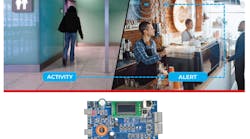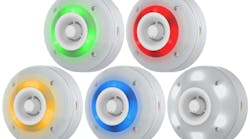The landscape of security has certainly changed since 1969. Many brands have just vanished, leaving orphaned dealers and installations behind. Some companies have been absorbed by larger ones and have lost their singularity and the qualities which enabled them to become established in the first place. The supply side of the industry has changed its rules many times, with many players now marketing direct to the end-user, and competing with their own customers by entering into the installation side of the industry.
NAPCO has been providing the independent dealer with security solutions since 1969, weathering the storms of change with a succession of innovative products and a focused corporate mission. Acquisitions have included door hardware manufacturer Alarm Lock and access control systems manufacturer Continental Instruments. Continuing to hone its core specialty of electronic security manufacturing, NAPCO has prospered and evolved as still independent, still loyal to its dealers.
Locksmiths who have been into electronic security for a while, like me, probably cut their teeth (and burned their first PROM) on a Magnum Alert, which I believe was the first microprocessor-based multi-zone alarm control panel, or at least the first one that worked. As mentioned, imitators and competitors have come (and gone) since 1969, but NAPCO prevails.
The new NAPCO Freedom reflects the maturity of NAPCO’s technology, its ability to come up with new ideas, and its awareness of the needs of the market and the challenges facing the industry, namely providing products which fit the demographic of strongest potential sales growth, and mitigating the false alarm crisis which threatens the residential alarm industry with extinction.
Those homeowners who have up until now felt they couldn’t afford a security system, didn’t really need one, thought alarm systems were ineffective, or were intimidated by the complexity of operating an alarm system represent an immense untapped market for new installations, and Napco plans to tap this market with the new Freedom line.
When a locksmith loses an account, he may not even know. The majority of his residential business is what we could refer to as casual or infrequent. You install a couple of deadbolts, and you probably will never hear from that client again, especially if he’s a satisfied customer.
But the revenue stream and business model of alarm installers is based partly on the recurring revenue from monitoring the alarm systems they install. That monthly payment from your subscribers is their way of renewing their vows with you.
Sometimes locksmiths criticize monthly recurring revenue by comparing installing a lock, which is a one-time charge and ostensibly brings the client a lifetime of safety and security, to an alarm dealer who bills the client monthly. Furthermore, everyone in the alarm installation business knows that because of competition and mass marketing, the general public is spoiled and have been trained to expect to pay little or nothing for their alarm system.
The cash flow model of the typical residential alarm dealer works something like this:
When an alarm system is installed, the dealer gets the client to sign a monitoring agreement in which the client agrees to pay $25 a month for a set term, five years in this example. In order to close the sale, the installer will frequently get little or no cash up front, and consequently may need to wait until into the third year of the contract to see a profit. The first three years of monthly payments go for the equipment he installed and the labor he expended. It also has to pay the central station, and his other bills. The remaining two years of the contract are ostensibly profit, but the dealer is still providing 24-hour a day, seven-day-a-week security, and maintaining accounts requires a certain amount of customer service.
But the realities are that clients die, get divorces, sell their homes, lose their jobs, or move away. Or they become disgruntled when they are unable to use their alarm because it intimidates them, or it keeps causing false alarms and they get warnings and fines from the police. They simply stop paying their bill, and if enough of a dealer’s clients stop paying, the dealer cannot afford to spend his life litigating them, and donate his bank account to his attorney. This is account attrition, which is said to have caused a crisis in some segments of the security industry.
Alarm Installation: Good for Locksmiths
The alarm installation business is good for locksmiths, and here is why.
The public is finally beginning to understand that they need both physical security (good locks) and electronic security (an alarm system) to achieve a rational and adequate level of security. As a consequence of changes in the alarm industry we just described, free alarm systems are less common, because the customers who can pass the rigorous credit check now required to qualify for credit are sophisticated enough to know they can get a better deal and a better system from an independent dealer who works for a living and is not an investment banker.
In addition, if the alarm installer is a locksmith, it is a given that he is a skilled craftsman, has credibility and is trustworthy enough to install locks and copy keys.
The locksmith has an additional business advantage by being diversified; probably offering other services and products; and perhaps a storefront to attract some retail. His eggs are not in one basket.
It certainly isn’t all rosy for old school locksmithing, and alarm installation may help fill the void many locksmiths are feeling from new competition like on-line marketers, home centers and lost automotive work.
The new Napco Freedom is of special interest to locksmiths because of its unique adaptation of the deadbolt into the system’s operation and security. And the product is distributed with the independent security dealer and the locksmith in mind.
Ease of operation and false alarm reduction measures are integral features of Freedom and will encourage sales and discourage complaints and fines for unnecessary police dispatches.
Other Features:
Freedom can be configured for homes with multiple deadbolts.
Freedom can be configured to monitor a garage door equipped with an opener. Many homeowners use their garage door as their primary means of entering and leaving their homes, and Freedom has technology to accommodate them.
Freedom incorporates a motion detector into the alarm keypad. This figures into the Freedom design, philosophy, and also simplifies installations.
Freedom supports up to eight zones and uses many of the same GEM family of wireless sensors and transmitters as other NAPCO security systems.
Freedom deadbolt and garage door security keypads can be interfaced with a larger conventional NAPCO Gemini panel as subzones, ideal for applications such as strip malls, multiple dwellings, storage units, etc.
Besides simple code-free (no keypad) arming and disarming, Freedom is supplied with digital keys (fobs) which may be used to further control the Freedom panel
System Overview
The NAPCO Freedom F-TP Touchpad Automatic Deadbolt Security System combines intuitive interactive arming with a passive disarming scheme, providing a system that is simple to use and extremely false alarm-resistant during the arming and disarming sequences (which is where 80 percent of false alarms occur).
The system is armed with a simple push of a button followed by the locking of the home’s deadbolt. Disarming is by unlocking the deadbolt. The microprocessor controlled F- TP touchpad uses information provided by its F-TAB deadbolt sensor and the PIR built into the Freedom ‘keypad’ to ensure foolproof operation. The touchpad’s integral wide-angle PIR motion sensor acts as an occupancy sensor that provides the microprocessor with activity information which prevents the user from making errors during the critical exit and entry periods. For example, if the user presses the AWAY button, opens and closes the door and locks the deadbolt but does not leave, the PIR will sense the user’s presence in the home and automatically default to STAY mode arming, preventing a false alarm.
If the system is armed in the AWAY mode, the F-TP touchpad PIR will prevent an intruder from approaching the deadbolt from inside the premises. If an intruder is detected by the built-in PIR, the system must be disarmed using the digital key fob.
The F-TAB deadbolt sensor, which is installed in the deadbolt strike hole, senses locking or unlocking, and sends this information to the touch pad microprocessor. The adaptive inductive F-TAB deadbolt sensor has no moving parts to break or wear out and self calibrates to compensate for aging of the deadbolt and the door and frame in which it is installed.
By allowing this level of system control without traditional numeric keypad interaction, the Freedom Touchpad System will provide a significant reduction in false alarms due to user error and also provide comfortable use of the system to those customers who might feel uneasy arming and disarming the system using a traditional keypad.
The Freedom system also supervises all deadbolts in the system, providing constant deadbolt status on the touchpad. This sophisticated feature, usually reserved for high-end systems, makes it impossible for the user to arm their system without first locking all deadbolts.
Freedom Specs
The NAPCO Freedom F-8 control panel is designed to work in conjunction with the Freedom F-8 Touchpad, comprising the deadbolt-activated security system. The system provides a maximum of eight zones, with Zone 1 (the door sensor) and Zone 2 (the integral PIR) monitored by the touchpad.
Zones 3 through 6 may be hardwired zones connected directly to the control panel or wireless devices reporting to an external (optional) GEM-RECV-XP8 receiver.
Zones 7 and 8 may be supported by an optional second touchpad (magnetic door contact and PIR), protecting a second exit/entry door, or be additional wireless devices.
The system supports a maximum of two touchpads, which may include the following models:
F-TP/TAB wireless touchpad (included in F-8K1T1)
F-TPG garage touchpad
F-TPBR bedroom touchpad
F-TP/TAB-H hardwired touchpad
In cases where the wireless F-TP/TAB touchpad is used, a second door may be supported with the use of the F-2D second door kit, which will transmit magnetic door contact and deadbolt status into the primary touchpad. If two wireless touchpads are used, a maximum of 4 deadbolts may be protected.
The system may be programmed through the F-PROG programming tool (optional), or the PCD-Windows downloading software, version 52 or higher.
For more information, call Napco at 800-645-9445 or visit www.napcosecurity.com.






